Microbiome (May the Fiber be with You, Cooking for
your Microbiome) (Lec. 18-19) ACTIVE LEARNING (11/23/20)
• There are trillions of microbes living on and inside us; esp diverse in our gut.
Saturday, November 21, 2020 12:23 PM • Microbiome: collection of micro-organisms living in a given environment.
○ Each person is born w/ unique microbiome; shaped by diet, experiences, exposures,
• Probiotics and prebiotics place of living.
○ Probiotics are living cultures. • Due to C-sections, less breast-feeding, and excessive antibiotics, babies' gut microbiome
• Usually transient; bacteria adapted to live in the environment they come from. are not as diverse as it once was.
• Most probiotics are aerobic, or can tolerate oxygen. ○ Ex. Babies passed thru the natural way have microbes that resemble the vagina.
○ Prebiotics are microbial accessible nutrients (ie like fiber).-> Provide nutrients to microbes! Babies passed thru c-sections have microbes that resemble skin. Due to lack of
• Gut microbial transplant-- replenish gut microbiome after antibiotics. protective microbes, c-section babies are more likely to develop asthma, allergies,
○ Ex. Fecal transplant. Pt w/ C. difficile infection had husband's stool bacteria delivered to her obesity.
colon. -> diarrhea and wasting symptoms went away in a day. • Less microbe diversity + more antibiotics -> colon cancer, diabetes, obesity.
• Phage therapy-- phages are used to target specific bacteria that may be resistant to antibiotics. ○ In US hospitals, pts are not eating enough fiber AND they are being fed antibiotics. -
○ Many phages are specific to a bacterial taxa. -> May be more efficient than antibiotics! > Promoting an unhealthy microbiome.
○ Plaque assay: goal is to detect and isolate phages. (1) form a bacterial lawn on a plate, (2) • Better understanding of microbes will allow us to application in agriculture/crop
mix in phages evenly spread out on agar, and (3) observe for clearance zones. Clearance productivity, climate science/carbon cycling, sustainable energy and bio-fuels, health and
zones = plaques--indicate viruses are eating the bacteria! medicine!
• Fiber: strong carbohydrate polymers that stay in digestive tract long enough for gut microbes to • The Human Microbiome project: million dollar project funded by NIH. Mapped out all the
have something to eat. ATCG (of microbes?) theyin the human body (n=200). Sectioned by body part they are
○ Have diversity in plant material (aka plant-based diet) so that microbes eat food instead of found in.
mucosal lining. • DNA of an individual is 99.9% similar to another individual. However, gut microbes only
○ Eating fiber improves efficacy of vaccines and to protect against influenza. share 10% similarity to another individual.
• (Expt) When switching the diet of South Africans (high fiber) and East coast Americans (high fat), • Child expt: Rapid setback after months of development, followed by a rapid recovery back.
researchers saw in: By end of 2yrs, child fecal microbiome looked similar to an adult's.
○ Americans: their microbiome moved towards fiber degraders, DEC in inflammation and • From expt data, we can design a microbiome in one individual by inoculating them with
microbes of another individual that have the desired traits.
markers of cancer risk.
○ Africans: microbiome towards fat degraders, INC in inflammation and markers of cancer ○ We can pilot human therapies using microbes by experimenting on mice.
risk. ○ Expt: transfer good microbes from a healthy donor to a patient w/ C. diff. -> All
• (Expt) "Studying the effects of a high-fiber diet on the gut microbiomes of college-aged students": symptoms (ie diarrhea) clear up and resemble donor's microbe community. And stay
undergrads took on a high-fiber diet in 2wks. healthy!
○ Learned that avocados and berries are high in fiber. Lentils and beans win.
○ Got college students to eat upwards of 40-50g of fiber/day. • Much more microbial genes than human genes in/on the human body. Ex. 23k human:
○ Significant effect on gut microbiome-- responsible for 9.5% of microbiome variation w/in the 8mil microbial genes.
• Distinct type of microbiome in dif parts of your body.
individual. (n=26)
○ HOWEVER, diversity trends lower on a high-fiber diest. Which is weird, b/c… ○ Oral cavity: many are anaerobes that ferment and tolerate low pH. FUN FACT Acid
from fermentation causes cavities.
• Eating >30 types of plants/wk is associated w/ higher gut microbial diversity.
• In adults, gut bacterial diversity depends on age, diet, and geography.
• In Stanford study(slide 23 in lec20), researcher believes molecules produced from fermented
foods (not fiber) are what promote microbial diversity.
○ Gut microbes across geography are unique based on lifestyle. Individuals from
○ Compared diversity of microbial species(ASVs) in fiber-rich diets to fermented food-rich industrialized countries have gut microbes suggest ppl are not eating many plant
fibers; instead, eating mucus lining gut. (compared to less industrialized countries)
diets.
• DIETARY FIBER Once in the colon, gut microbes convert fiber into fermented products, ie
○ US immigrants show that gut microbes move toward bacteriophages than Previolta.
???
butyrate; those short-chain fatty acids are the preferred fuel for cells lining the intestine.
○ W/o fermentation products, leads to stalled development of stem cells within intestine, INC • Characterizing microbial diversity: Evenness of distr and Abundance.
○ Alpha diversity: species per site and within sample. Beta diversity: variation b/w
in cancer risk, and altering of cell metabolism. Tight junctions become weak, molecules leak
sites.
out b/w gut cells -> toxic to body.
○ Fermentation: breakdown of foods thru anaerobic conditions (w/o oxygen). • Multivariate data: Each dots represent… Dots close together--> similar samples/microbial
community composition.
○
• Avoid white flour, white rice, white starches-- just as bad as sugar. Challenge yourself to eat as
much different plants as possible. Ex. Avocado toast on whole grain bread instead of white
bread.




